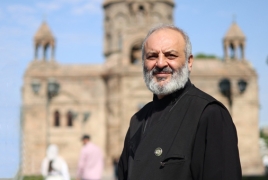
Security forces began raids on the homes of supporters of the “holy struggle” movement on the morning of June 25, according to the movement’s Telegram channel.
A statement read that “law enforcement is also operating at the residence of Archbishop Bagrat Galstanyan.”
The Investigative Committee (IC) has announced that participants and leaders of the “Holy Struggle” movement were planning “terrorist actions and efforts to seize state power in Armenia.”
According to the committee, Bagrat Galstanyan created and led the “holy struggle” movement for several months, initially seeking power via constitutional means. But since November 2024, he allegedly resolved to use unconstitutional methods. With followers, he formed a group that acquired tools and technical means for terrorism and power seizure, and intentionally created conditions to prepare for these actions.
In summer 2024, Galstanyan founded the movement and organized public gatherings and marches addressing domestic and foreign policy issues. These events aimed at gaining legislative and executive influence. When unsuccessful, the movement paused. Aware that power belongs to the people under Article 2 of the Constitution and that power usurpation is criminal, Galstanyan, while formally acknowledging rights to free speech and assembly, opted instead for armed struggle.
He ruled out election participation, stating the movement should operate through small coordinated armed groups. Through discussions, Galstanyan and his associates decided to form 200‑250 strong shock units, each with up to 25 members—mostly former soldiers and officers. These units had specific tasks, operating independently without inter-group coordination.
Galstanyan planned to protest near government buildings while shock groups, pre-positioned elsewhere, launched actions separate from the public protest, which was to serve as a diversion. Their goal was to destabilize various locales across the republic within 24–36 hours.
Leadership used psychological and propaganda techniques, delegating main actions to those termed “adventurers.”
They intended terror through potential human casualties, serious injuries, major property damage, and destruction of public buildings and systems. Plans included blowing up tunnels, staging car crashes in Yerevan and elsewhere, targeting transport nodes, damaging or burning vehicles to paralyze traffic. They envisaged simultaneous bombings and shootings at buildings, mass destruction of power, communication systems, traffic lights, trolleybus networks, and public service facilities, aiming to instill fear.
They also planned to hinder state response by blocking police movements, damaging vehicles, and conducting cyberattacks on government websites and electronic systems to disrupt state functions and pressure authorities to resign.
From January 2025, the group began recruiting over 1,000 members via supporters. They purchased Yerevan maps, gathered intelligence on vulnerabilities in traffic lights, power and communication networks, procured thousands of explosives and firearms, and devices to disable vehicles. Recruiting of shock group cadres continued, with meetings urging leaders to strengthen resolve and readiness.
However, Galstanyan and associates failed to act, as National Security Service agents uncovered the plot in the preparatory stages.
The investigative body has initiated an urgent criminal investigation.
The IC stated that within the criminal case, all legal and procedural measures will be taken to ensure all group members face proper criminal justice, urging the public to resist provocations and maintain lawful conduct.
On June 24, Prime Minister Nikol Pashinyan shared on Facebook an article by civic.am titled “opposition’s coup plan,” writing: “This process will go down in history as a ‘failed coup by stabbers.'”

